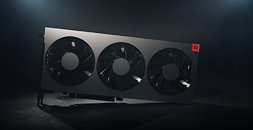Thursday, January 10th 2019

NVIDIA CEO Jensen Huang on Radeon VII: "Underwhelming (...) the Performance is Lousy"; "Freesync Doesn't Work"
PC World managed to get a hold of NVIDIA CEO Jensen Huang, picking his thoughts on AMD's recently announced Radeon VII. Skirting through the usual amicable, politically correct answers, Jensen made his thoughts clear on what the competition is offering to compete with NVIDIA's RTX 2000 series. The answer? Vega VII is an "underwhelming product", because "The performance is lousy and there's nothing new. [There's] no ray tracing, no AI. It's 7nm with HBM memory that barely keeps up with a 2080. And if we turn on DLSS we'll crush it. And if we turn on ray tracing we'll crush it." Not content on dissing the competition's product, Jensen Huang also quipped regarding AMD's presentation and product strategy, saying that "It's a weird launch, maybe they thought of it this morning."Of course, the real market penetration of the technologies Jensen Huang mentions is currently extremely low - only a handful of games support NVIDIA's forward-looking ray tracing technologies. That AMD chose to not significantly invest resources and die-space for what is essentially a stop-gap high-performance card to go against NVIDIA's RTX 2080 means its 7 nm 331 mm² GPU will compete against NVIDIA's 12 nm, 545 mm² die - if performance estimates are correct, of course.The next remarks came regarding AMD's FreeSync (essentially a name for VESA's Adaptive Sync), which NVIDIA finally decided to support on its GeForce graphics cards - something the company could have done outright, instead of deciding to go the proprietary, module-added, cost-increased route of G-Sync. While most see this as a sign that NVIDIA has seen a market slowdown for its G-Sync, added price-premium monitors and that they're just ceding to market demands, Huang sees it another way, saying that "We never competed. [FreeSync] was never proven to work. As you know, we invented the area of adaptive sync. The truth is most of the FreeSync monitors do not work. They do not even work with AMD's graphics cards." In the wake of these word from Jensen, it's hard to understand the overall silence from users that might have their FreeSync monitors not working.
Reportedly, NVIDIA only found 12 out of 400 FreeSync-supporting monitors to support their G-Sync technology automatically in the initial battery of tests, with most panels requiring a manual override to enable the technology. Huang promised that "We will test every single card against every single monitor against every single game and if it doesn't work, we will say it doesn't work. And if it does, we will let it work," adding a snarky punchline to this matter with an "We believe that you have to test it to promise that it works, and unsurprisingly most of them don't work." Fun times.
Source:
PC World
Reportedly, NVIDIA only found 12 out of 400 FreeSync-supporting monitors to support their G-Sync technology automatically in the initial battery of tests, with most panels requiring a manual override to enable the technology. Huang promised that "We will test every single card against every single monitor against every single game and if it doesn't work, we will say it doesn't work. And if it does, we will let it work," adding a snarky punchline to this matter with an "We believe that you have to test it to promise that it works, and unsurprisingly most of them don't work." Fun times.



270 Comments on NVIDIA CEO Jensen Huang on Radeon VII: "Underwhelming (...) the Performance is Lousy"; "Freesync Doesn't Work"
Also AMD has much less value, therefore they lost less in pure numbers, not percentages.
Smartcom
While, Wow just wow no one stop this guy? He thought his stock has been tanking this kind of tantrum from a CEO just drove it off the cliff!
Calling the Vega 7 "underwhelming" it matches the 2080 at the same price, his understanding of the word escape's him. Now while I wait to see reviews, I might say his company delivered "underwhelming"... at such price first. There's never truly bad cards just bad price points.
As to FreeSyn when your company just came out saying they are going to now support the VERSA adaptive Sync it, but says "does not work" I'm not interested in consider using your hardware, i'll go with a proven and working solution. Ah, so get your crack driver team to make it work on your cards, don't blame the an open source VERSA specification you never want to support or give input to, and now that your behind the 8-Ball can't seem to get it to work with your hardware. The chicken came to roost...
It seems like he's seeing AMD doing a "Ryzen" and instead of keeping a "stiff upper lip" like Intel did he freaked out, and this is not near as bad as Intel had it. Navi will be coming soon and I'd want to believe AMD will have more mainstream pricing for parts that does strong 1440p. Then he's realizes he's up against a Navi/HBM2 on 7mm part, and has no idea how that might turn out but is said to be more gaming than a Vega compute architecture. AMD is already proven they can 7mn, so it to be Navi gains on a big chip that's on 7nm, who knows. At this point the next thing might be he found out AMD has product lining up from the "Instinct geldings" and strong HBM2 supplies, and can fill the channel way better the first Vega. Jensen Huang knows AMD is in a better place to work down price if they can maintain strong product levels, while his investors would freak on him.
Find me Popcorn...
As for 48-75Hz, it sure beats locked 60Hz, which is what you'd otherwise get for that price. Added flexibility and higher refresh rates at the same price is a win for me. Would you rather have locked 60p? You're right that the lower bound requirement is an advantage for GSync, but other than that, it's a question of the panel quality. Also, what do you think of all the 60Hz 4k GSync panels? Are they equally useless?
Wow...
Besides, who cares about CEO's nowadays? they are replacable like batteries. He's just a 3D printed bureoucrat
It's not a very compelling story at the moment.
So the bottom line is that AMD has a competitive product if they can price just under a 2080 which they probably will, in due time at the very least. That means the days of 2080 are numbered, because it is a very large die with some R&D budget behind it, while AMD is surfing the Vega wave they already paid for - dearly I'd say - and they have a smaller die with much better yields per wafer. That alone can offset their HBM2 expenses and create a margin that enables them to move along with any Nvidia price cuts. The only caveat is power consumption, but I'm getting the impression more and more people are willing to overlook that just for giving Nvidia a kick in the arrogant nuts. I would - if I was in the market for such a card.
In the end, Radeon 7 is essentially the long awaited 1080ti performance everyone wanted since the card launched. The 1080ti did that within a 255W power budget (more if you OC)... so how bad is it, really. 7nm is just enough to keep AMD in the game, in quite a convincing way. Its not ideal, but its a counterweight for certain.
You got Lemons, a little work and you make good money selling Lemonade. Easy peasy lemon squeezy!
Nvidia had a fantastic idea with RTX: it not only looks better, but it effectively helps developers finish games faster. It's sensational. I wish them all the best of luck with that.
While AMD, with its unlimited army of trolls does nothing, no innovation, and I'd be the first to shake AMD's hands if they finally did something to advance the industry. I want more games, I want hardware that helps devs finish games faster, I want to see some innovation finally